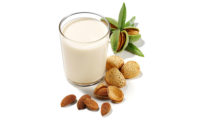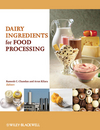Researching Dairy-based Drinks and Desserts






This offers opportunities for food manufactures marketing dairy products to all food distribution channels, including retail, foodservice and even schools. In order to create unique dairy beverages and desserts that maintain flavor and product stability over time, wide arrays of ingredients are available to help with any issue.
Stabilization
“Stabilizers are added to dairy-based beverages and desserts in order to influence both texture and stability,” states Donna Klockeman, Ph.D., dairy food scientist, at a well-known gum supplier. Consumers experience texture while interacting with the food. Hydrocolloids are added to dairy beverages and desserts to change or enhance this interaction. Creamy and smooth textures are strongly associated with dairy beverages and desserts, and many ingredients are available to promote and maintain this mouthfeel. The stability of dairy products is also influenced by ingredients, such as hydrocolloids. “Thickened systems, like puddings, yogurts, mousse or cheesecake, for example, naturally release water over time (i.e., syneresis), which can be managed by the water-loving nature of hydrocolloids. This interaction is also used to increase freeze-thaw stability in frozen ice cream and desserts,” adds Klockeman.
Because of the nature of milk and dairy ingredients, stabilization is often necessary to protect the delicate proteins and other components from negative ingredient reactions. For example, food components, like proteins, can have both positive and negative interactions with hydrocolloids, such as carrageenan and xanthan gum.
Many synergies are known between hydrocolloids, and also between proteins and/or minerals and hydrocolloids, some of which are affected by processing and other ingredients. Suppliers help product developers select ingredients and stabilizer systems to match the desired texture, processing and storage conditions of the finished product. Stabilizers chosen are usually blends of ingredients, which might include hydrocolloids, emulsifiers, salts, starches and dietary fibers.
Proteins, pH and Stabilizers
Nutritional evidence is mounting that suggests milk proteins have a positive effect on weight management and building lean muscle. Interest in dairy protein fortification of dairy beverages is strong; thus, stabilization of these ingredients is an important consideration in the formulation of dairy-based beverages and certain desserts. For example, whey protein, a naturally occurring milk protein, has become a popular protein source for healthy beverages and other foods because of its nutritional benefits and its clean, natural flavor. Casein, the other high-quality milk protein (which may also contain the mineral calcium, depending on its form), is increasingly being used as a protein supplement, as well.
Some experts are even suggesting the recommended daily allowance for protein should be re-evaluated for certain groups of people, such as children, athletes and seniors. It is also theorized that spacing protein in optimized amounts throughout the day can maximize its benefits, providing more opportunity for dairy protein beverages and other dairy snack-like products.
A food’s pH is a factor in stabilizer selection. Acidic fruit ingredients and dairy proteins generally do not do well together, without the benefit of stabilization. “Pectins are often used in lower-pH products, including smoothies and drinkable yogurts. Agar is a traditional hydrocolloid added to manage syneresis and is now available in 100% certified-organic form. Locust bean gum and guar gum are also commonly added to aid in freeze-thaw stability of desserts and are also available in 100% certified organic,” Klockeman offers.
Labeling restrictions, formulations and product processing are determining factors in choosing stabilizer systems. Examples of these restrictions include organic and “all-natural” claims on products. For another example, chocolate milk made using traditional processing generally contains only carrageenan. However, when shelf-stability is required or UHT processing is used, chocolate milk includes a blended stabilizer system, including cellulose gel, mono- and diglycerides, sodium tripolyphosphate, cellulose gum and carrageenan, says Klockeman. This same spectrum exists for frozen desserts.
All-natural ice cream may utilize tara gum, locust bean gum and guar gum as stabilizers. In contrast, reduced-fat ice cream with a higher level of overrun may use a blended stabilizer system (for example, with propylene glycol esters, calcium sulfate, cellulose gum, guar gum, maltodextrin, modified food starch and carrageenan) to enhance texture and control ice crystal growth.
“Ice creams and frozen products also benefit from addition of gelatin, a collagen protein. Its benefits include crystallization control, heat-shock resistance and texture maintenance. In low-calorie or –fat desserts, it improves texture by water-binding and improving adhesiveness,” states Mindi McKibbin, technical services specialist at a supplier of collagen proteins.
“Gelatin is often used in dairy products to contribute to creamy mouthfeel, especially in low-fat yogurts, due to its ‘melt-in-your-mouth’ feel. Gelatin’s melting point is near body temperature, thus contributing to the feeling of a full-fat version,” McKibbin adds.
Preventing syneresis in many dairy-based applications, gelatin can also prevent whey from being expelled in yogurts, curds and cream cheeses—where it binds and stabilizes the whey. The gelatin molecules form a lattice in the casein gel during the gelling process, which is stabilized by hydrogen bonding, preventing the protein from clumping and liquid whey being expelled.
Sucrose esters are another ingredient that can help with aeration, emulsification and protein stabilization of dairy products, according to a supplier website. Aerated products, such as mousse, ice cream or toppings, benefit from strong surfactants, like sucrose esters, which help ease the whipping process and create small, stable oil droplets that enhance the creamy mouthfeel. Another advantage of sucrose esters is their strong surfactant activity, without the soapy taste.
The chemical structure of sucrose esters allows them to interact with dairy proteins by means of hydrophilic and/or hydrophobic bonding. Dairy proteins are less sensitive to high temperature or low pH. Feathering and flocculation in beverages and creamers can also be prevented.
Flavoring
“In order to impart the characterizing flavor profile, adding flavoring ingredients is often needed in dairy beverages and desserts. For example, it can be challenging to achieve a desired caramel- or mocha-type product without added flavor ingredients,” says Jeff Foss, principal scientist at a major flavor house. Additionally, as fresh ingredients are often used in desserts, there can be variability in the crops from year to year, and flavor helps to maintain product consistency.
Flavors act as extenders for fruits and other non-flavor characterizing ingredients, and they can influence mouthfeel perception in products like flavored creams. Flavors can also be useful to mask off-notes and modify taste, due to addition of high-intensity sweeteners, added vitamins or other functional ingredients.
A product’s flavor profile can help to define the time of day and occasion it is consumed, which is a great way to expand user base and use frequency. For dairy beverages, this fits well with the trend of beverages increasingly being used for snacking. Dairy is also showing up as the base for various functional drinks, such as nutritional, meal replacement and sports recovery products, so choosing the right flavor that resonates with the demographic and lifestyle/activity is important.
When it comes to flavoring dairy-based beverages and desserts, standard fruit flavors are still quite popular, but the fruit types are changing. This also holds true for “dairy-like” categories, such as soy milk. “Fruit flavors drive sales of yogurts and yogurt-based beverages, and we are seeing a move towards more tropical and blended flavor profiles, such as mango, passion fruit and dessert-type flavors, as yogurts are marketed as a healthier alternative to higher-calorie desserts,” adds Foss.
“Indulgent flavors, such as cookies and cream and red velvet cake, are tracking well, especially in reduced-fat or -sugar products, where they can give the perception of indulgence--despite the reduction,” adds Trina Murray, beverage scientist at another leading flavor company. And, Superfruits, like pomegranate, blueberry and goji, which have transitioned from ingredients into flavors, have gained traction in both beverages and desserts.
In the U.S., flavored milks are still driven by standard classic chocolate, vanilla and strawberry; whereas, globally, flavors for milks are much more diverse and include many fruit offerings. “We are starting to see more milk-based beverages with fruit flavors and flavor blends, such as blueberry vanilla, chocolate raspberry and orange cream,” says Foss.
The preference for either natural or artificial flavor is highly dependent upon the brand and product positioning, but the trend continues toward natural. There are still a significant number of products with natural and artificial flavors (N&A), or just artificial, particularly in foodservice products—because the labels are not seen by the end consumers. “In retail, there is a continued push toward simple ingredient statements, but, depending on the market, both natural and artificial flavors can work in dairy beverages and desserts, and deliver great-tasting products,” states Murray.
Factors Impacting Flavors
The frequent use of dairy proteins and calcium in nutritional and workout recovery drinks reinforces the need for flavoring ingredients and stabilizers. Protein and mineral interactions may not only need stabilization, but can also affect flavor needs.
“Ingredient interactions to watch out for,” advises Foss, “include dairy-based proteins, which are impacted by heat processing, pH and certain added minerals; therefore, the product must be properly stabilized.” Alcohol (ethanol) -based flavors can shock dairy proteins, if added incorrectly, and certain flavor components interact with dairy proteins and “fade,” or are absorbed more quickly over time. The application or protein level and type must be taken into account when constructing the flavor. Keep in mind the increasing use of dairy proteins at higher levels for a variety of healthy beverages and reduced-fat, indulgent desserts. Flavor choice also depends on product type and pH. For example, chocolate does not work well with acidic products, and some sharp fruit flavors, like pineapple, do not work well in neutral-pH products.
In addition to frozen and refrigerated products, shelf-stable dairy beverages are also becoming more common. Processing temperatures and methods vary, depending on the product’s ultimate distribution and storage conditions; the proper flavor carrier and profile must be chosen to meet these needs. In addition, different storage conditions require the product to have different stabilizers, which may also influence flavor choice.
Dairy is a unique category with amazing opportunities and complex challenges. Dairy beverages have a wide array of types, uses and applications, including everyday use, sports recovery, muscle building and meal replacement, as well as nutritional supplementation of the young and old. Dairy beverages, ranging from milks, flavored milks and yogurt drinks, to name a few, benefit from added stabilizers of various kinds and flavors for every occasion. Dairy desserts and higher-fat dairy products may soon increase in demand and variety, with modern nutritional information showing saturated fat does not cause health problems once thought to be true. In addition, research shows numerous other health benefits of dairy components, such as proteins, peptides and minerals, and these properties only add to the explosion of dairy desserts and beverages which may require stabilizers and flavors to achieve desired taste, texture and stability. Suppliers are always the go-to source for help with issues in formulating stabilizer and flavor systems for dairy beverages and desserts. pf
Looking for a reprint of this article?
From high-res PDFs to custom plaques, order your copy today!









